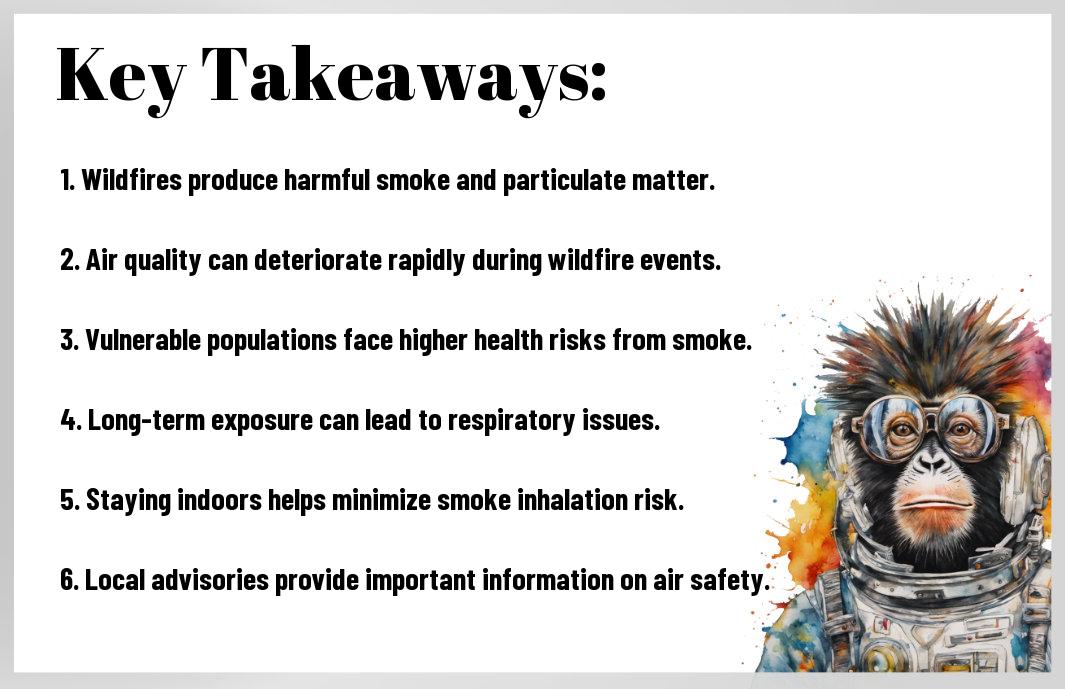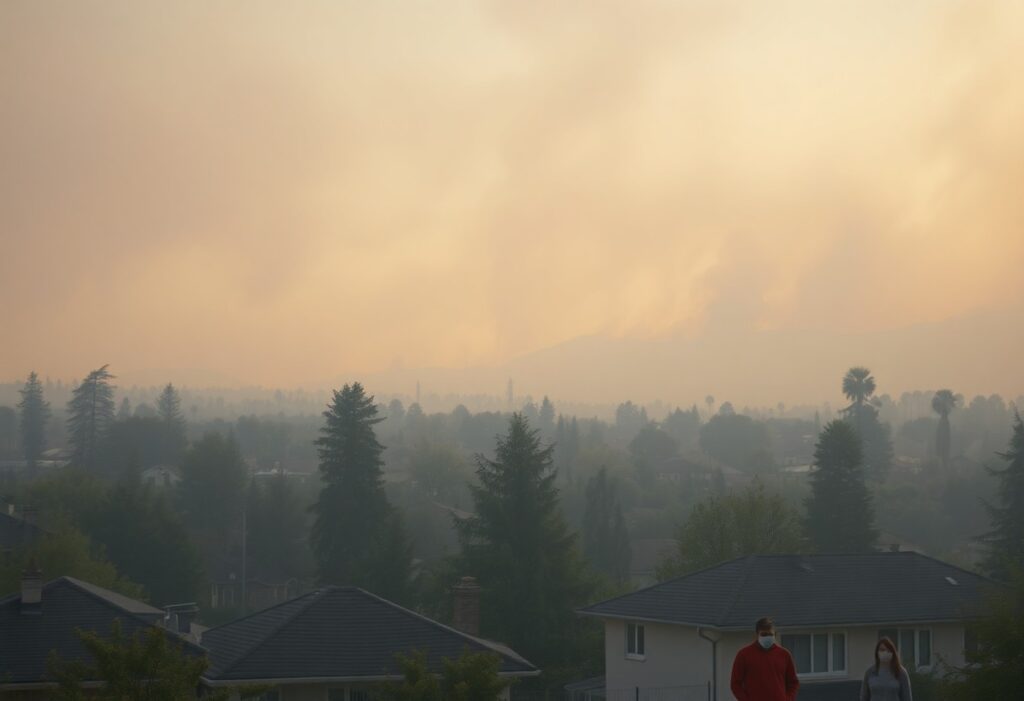Wildfires can drastically impact your local air quality, posing serious risks to your health. When smoke and particulate matter fill the air, it can lead to irritations in your lungs and throat, and exacerbate existing respiratory issues. Prolonged exposure can even increase the risk of cardiovascular problems. It’s crucial to stay informed about air quality levels and take proactive measures to protect yourself, especially during wildfire season. Understanding how wildfires affect the air around you empowers you to make better choices for your well-being and that of your community.
Understanding Wildfires
The phenomenon of wildfires has gained significant attention due to their increasing prevalence and impact on ecosystems and communities. These uncontrollable fires can erupt in forests, grasslands, and even urban areas, fueled by various natural and human-made factors. Understanding wildfires is crucial for recognizing their consequences, particularly regarding local air quality and your health.
Causes of Wildfires
On a global scale, wildfires are typically attributed to a mix of natural elements—such as lightning strikes—and human activities, including careless campfires, discarded cigarettes, and agricultural practices. Rising temperatures and prolonged drought conditions also contribute to the likelihood of wildfires, making it crucial for you to be aware of your surroundings and take preventive measures.
Geographic Distribution and Frequency
With climate change and the increase in extreme weather events, wildfires are becoming more frequent in many regions, particularly in the western United States, Australia, and Mediterranean countries. Areas prone to dry conditions, such as deserts and grasslands, tend to experience a higher incidence of wildfires, affecting local populations.
Plus, understanding the geographic distribution of wildfires is vital for recognizing which areas are most at risk. Regions like California see more than 8,000 wildfires annually, while Australia’s bushfire seasons are becoming increasingly intense. This frequency not only threatens natural habitats but also poses serious risks to public health. The smoke from these fires can travel hundreds of miles, leading to poor air quality and respiratory issues for communities far from the flames. Knowing your local wildfire risk can help you take necessary precautions to safeguard your health and well-being.
The Science of Air Quality
Even the most minor changes in your environment can significantly impact air quality. Wildfires release a variety of pollutants into the atmosphere, elevating the risks associated with breathing in contaminated air. Understanding how these pollutants interact gives you a better insight into their effects on your health and the ecosystem.
Key Air Pollutants Generated by Wildfires
About the pollutants released during wildfires, you should be aware that they include fine particulate matter (PM2.5), carbon monoxide, volatile organic compounds (VOCs), and nitrogen oxides. These substances can infiltrate your lungs and bloodstream, posing serious health risks, including respiratory issues and cardiovascular diseases.
Measurement and Monitoring Techniques
Any effective approach to tackling air quality issues involves accurate measurement and monitoring of pollutants. This includes using air quality monitoring stations and portable sensors that provide data on pollutant levels in real-time, allowing you to make informed decisions about outdoor activities and safeguard your health.
It is vital that you stay informed about air quality through continuous monitoring. Utilizing advanced technologies such as real-time air quality sensors and satellite imaging helps assess the concentration of hazardous pollutants. These methods enable you to track air quality changes during wildfires and make timely decisions to protect your health. The data collected ensures you are aware of high-risk periods, allowing you to minimize exposure to dangerous levels of pollutants.
Short-term Health Effects
It is necessary to recognize the short-term health effects that can arise from wildfires. As smoke and particulates fill the air, your body may respond negatively, leading to a range of health issues. The quality of the air you breathe can significantly diminish, increasing the likelihood of experiencing serious health complications. These effects can be particularly pronounced for vulnerable populations, such as children and the elderly.
Respiratory Issues
By inhaling smoke from wildfires, you may experience various respiratory problems. Common symptoms include coughing, shortness of breath, and worsening of pre-existing conditions like asthma or chronic obstructive pulmonary disease (COPD). Even otherwise healthy individuals can suffer temporary respiratory distress when exposed to high levels of smoke and particulate matter.
Cardiovascular Effects
One of the lesser-known impacts of wildfires is their effect on your cardiovascular system. Exposure to wildfire smoke can lead to inflammation and stress on the heart, elevating your risk for heart attacks and strokes. Your blood vessels may experience constriction, and if you have existing heart conditions, the danger becomes even more pronounced.
Cardiovascular issues can arise due to the fine particulate matter present in wildfire smoke, which can enter your bloodstream and cause inflammation. This inflammation affects your heart and blood vessels, increasing the likelihood of serious problems such as arrhythmias or even sudden cardiac events. If you have health conditions like hypertension or heart disease, the risks are significantly elevated. It is vital to take preventive measures during wildfire events to protect your heart and overall health.
Long-term Health Risks
All wildfires can significantly impact your long-term health by exposing you to harmful pollutants. Prolonged exposure to smoke can lead to respiratory issues and exacerbate existing health conditions. For insight on how wildfires specifically affect your health, visit Fires and Your Health.
Chronic Diseases
Around 4.4 million people worldwide suffer from chronic respiratory diseases, with exposure to wildfire smoke potentially worsening these conditions. The fine particulate matter found in smoke can penetrate deep into your lungs, leading to increased hospital visits and worsening symptoms.
Vulnerable Populations
The elderly, children, and individuals with pre-existing health conditions are among the most affected by wildfire smoke. These vulnerable populations may experience heightened sensitivities that put them at increased risk of serious health complications.
But protecting these vulnerable groups is vital. You should be aware that the effects of wildfire smoke can be particularly severe for the elderly and those with heart and lung diseases. Planning ahead with safety measures and staying informed can help lessen the impact, ensuring that you and your loved ones are less susceptible to the long-term risks associated with wildfires.
Mitigation Strategies
After a wildfire, implementing effective mitigation strategies is crucial for maintaining local air quality and protecting your health. Engage in proactive measures, such as creating firebreaks and managing vegetation, to help reduce the intensity and spread of future wildfires. Regularly monitoring air quality and setting up community alerts can keep you informed. Additionally, advocating for local policies that prioritize land management and fire safety can strengthen community resilience against wildfires.
Community Preparedness
Behind every resilient community lies a well-prepared population. Organizing community workshops and drills focused on wildfire response can enhance local readiness. Encourage your neighbors to create and share emergency plans that outline safe evacuation routes and support systems. Establishing communication networks, such as text alerts or social media groups, ensures that you receive timely information on air quality changes and fire updates.
Personal Protective Measures
Any individual can take specific actions to protect themselves from unhealthy air quality during wildfires. Prioritize staying indoors during severe smoke events, and use air purifiers to lessen indoor pollutants. If you must venture outside, wear a N95 respirator mask to filter out fine particles. Additionally, understanding air quality indexes and using apps to track local conditions can guide your daily activities.
In fact, employing personal protective measures during wildfires not only safeguards your health but also supports your overall well-being. You should invest in a high-quality air purifier for your home, as it can significantly reduce indoor air pollution. Keep your windows and doors closed during heavy smoke events to prevent outdoor contaminants from entering. If you have existing respiratory issues, consider consulting with your healthcare provider about preventive treatments or medications you may need during wildfire season, ensuring that you are prepared to respond effectively to compromised air quality.
Policy and Regulation
Your understanding of policies and regulations surrounding wildfire management is key to navigating the effects on air quality. Governments at various levels implement policies that can mitigate the impact of wildfires. These include guidelines for land management, fire prevention practices, and standards for air quality. Being informed about these regulations can empower you to make better decisions for your health and safety during wildfire events.
Air Quality Standards
Above all, air quality standards set by environmental agencies provide benchmarks for pollutants that affect your health. These standards are designed to protect you from the harmful effects of wildfire smoke, which contains particulate matter and toxic compounds. When wildfires occur, agencies may issue advisories based on real-time air quality monitoring, informing you of the risks associated with outdoor activities.
Smoke Management Policies
Smoke management policies are necessary for reducing health risks during wildfires. These regulations include strategies for planning and controlling prescribed burns and minimizing smoke dispersion. This ensures you can breathe easier during fire events.
Indeed, effective smoke management policies are critical in reducing the health risks associated with wildfires. These policies involve meticulous planning to control the timing and intensity of burns, ensuring that smoke disperses in a manner that minimizes its impact on populated areas. Furthermore, collaboration among agencies helps in sharing information and implementing measures that protect vulnerable populations, ensuring your community has clear guidelines and notifications regarding air quality fluctuations. Understanding these policies can help you to act proactively to safeguard your health during wildfire episodes.

Final Words
From above, it’s clear that wildfires significantly impact local air quality, which in turn affects your health. As smoke billows into the atmosphere, harmful particulates and gases can infiltrate your lungs, exacerbating respiratory conditions and leading to other health complications. Staying informed about air quality reports and taking precautions, such as staying indoors and using air purifiers, can help protect your well-being. Your awareness and proactive measures are vital in safeguarding your health during wildfire events.











